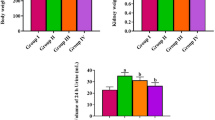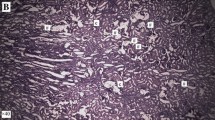Abstract
The association between serum gonadal steroids and urolithiasis in males received only limited attention. Calcium oxalate urolithiasis is induced by administration of ethylene glycol in drinking water. It appears that the administration of natural antioxidants has been used to protect against nephrolithiasis in human and experimental animals. The purpose is to study the potential role of antioxidants as inhibitors of high plasma androgenic markers or hyperandrogenicity in the pathogenesis of ethylene glycol-induced nephrolithiasis in Wistar rats. Male Wistar rats were studied in 4-week period. Group 1 (control) was fed a standard commercial diet. Group 2 received the same diet with 0.5 % of ethylene glycol. Group 3 received EG plus the diet and water added with antioxidant nutrients and lime juice as the dietary source of citrate. Group 4 and Group 5 were treated similar to Group 2 and Group 3 with 0.75 % of ethylene glycol. For antioxidant supplementation, the standard diet enriched with 4,000.0 μg vitamin E and 1,500.0 IU vitamin A for each rat per day added to the diet once a week, and provided daily with 5.0 mg vitamin C, 400.0 μg vitamin B6, 20.0 μg selenium, 12.0 mg zinc, and 2.0 mg boron for each rat per day in their drinking water. After treatment period, collection of blood was performed and kidneys were removed and used for histopathological examination. The results based on various assays, measuring size of crystal deposition, and histological examinations showed that high concentration of androgens acts as promoter for the formation of renal calculi due to ethylene glycol consumption and the inhibitory role of antioxidant complex in the formation of renal calculi disease. Data revealed that the size and the mean number of crystal deposits determined in EG 0.75 % treated groups (G4) were significantly higher than the EG-treated groups, added with antioxidant nutrients and lime juice (G5). The mean concentration of androgens in Group 4 increased after EG 0.75 % administration, and decreased after antioxidants supplementation in Group 5. Elevated concentration of androgens (as promoters of the formation of renal calculi) as a result of EG consumption and their decreasing following antioxidant supplementations along with the slight decrease in malondialdehyde level provides a scientific rational for preventive and treatment roles of antioxidant nutrient complex in kidney stone disease.

Similar content being viewed by others
References
Curhan GC (2007) Epidemiology of stone disease. Urol Clin North Am 34:287–293
Fan J, Glass MA, Chandhoke PS (1989) Effect of castration and finasteride on urinary oxalate excretion in male rats. Urol Res 26:71–75
Patel P, Patel M, Saralai M, Gandhi T (2012) Antiurolithiatic effects of Solanum xanthocarpum fruit extract on ethylene-glycol-induced nephrolithiasis in rats. J Young Pharm 4:164–170
Lee YH, Huang WC, Huang JK, Chang LS (1996) Testosterone enhances whereas estrogen inhibits calcium oxalate stone formation in ethylene glycol treated rats. J Urol 156:502–505
Yoshioka I, Tsujihata M, Momohara C, Akanae W, Nonomura N, Okuyama A (2010) Effect of sex hormones on crystal formation in a stone-forming rat model. Urology 75:907–913
Yagisawa T, Ito F, Osaka Y, Amano H, Kobayashi C, Toma H (2001) The influence of sex hormones on renal osteopontin expression and urinary constituents in experimental urolithiasis. J Urol 166:1078–1082
Ozbek E (2012) Induction of oxidative stress in kidney. Int J Nephrol. doi:10.1155/2012/465897
Naziroglu M, Karaoğlu A, Aksoy AO (2004) Selenium and high dose vitamin E administration protects cisplatin-induced oxidative damage to renal, liver and lens tissues in rats. Toxicology 195:221–230
Huang HS, Ma MC, Chen J (2009) Low-vitamin E diet exacerbates calcium oxalate crystal formation via enhanced oxidative stress in rat hyperoxaluric kidney. Am J Physiol Renal Physiol 296:F34–F45
Santhosh Kumar M, Selvam R (2003) Supplementation of vitamin E and selenium prevents hyperoxaluria in experimental urolithic rats. J Nutr Biochem 14:306–313
Bardaoui M, Sakly R, Neffat F, Najjar MF, El Hani A (2010) Effect of vitamin A supplemented diet on calcium oxalate renal stone formation in rats. Exp Toxicol Pathol 62:573–576
Selvam R (2002) Calcium oxalate stone disease: role of lipid peroxidation and antioxidants. Urol Res 30:35–47
Ortiz-Alvarado O, Miyaoka R, Kriedberg C, Moeding A, Stessman M, Monga M (2011) Pyridoxine and dietary counseling for the management of idiopathic hyperoxaluria in stone-forming patients. Urology 77:1054–1058
Atakan IH, Kaplan M, Seren G, Aktoz T, Gül H, Inci O (2007) Serum, urinary and stone zinc, iron, magnesium and copper levels in idiopathic calcium oxalate stone patients. Int Urol Nephrol 39:351–356
Naghii MR, Einollahi B, Rostami Z (2012) Preliminary evidence hints at a protective role for boron in urolithiasis. J Altern Complement Med 18:207–209
Touhami M, Laroubi A, Elhabazi K, Loubna F, Zrara I, Eljahiri Y et al (2007) Lemon juice has protective activity in a rat urolithiasis model. BMC Urol 7:18
Travison TG, Araujo AB, Hall SA, McKinlay JB (2009) Temporal trends in testosterone levels and treatment in older men. Curr Opin Endocrinol Diabetes Obes 16:211–217
Li JY, Zhou T, Gao X, Xu C, Sun Y, Peng Y et al (2010) Testosterone and androgen receptor in human nephrolithiasis. J Urol 184:2360–2363
Finlayson B (1974) Symposium on renal lithiasis. Renal lithiasis in review. Urol Clin North Am 1:181–212
Curhan GC (1999) Epidemiologic evidence for the role of oxalate in idiopathic nephrolithiasis. J Endourol 13:629–631
Fan J, Chandhoke PS, Grampsas SA (1999) Role of sex hormones in experimental calcium oxalate nephrolithiasis. J Am Soc Nephrol suppl 14:S376–S380
Naghii MR, Hedayati M (2010) Determinant role of gonadal sex hormones in the pathogenesis of urolithiasis in a male subject—a document for male predominancy (case study). Endocr Regul 44:143–146
Watson JM, Shrewsberry AB, Taghechian S, Goodman M, Pattaras JG, Ritenour CW et al (2010) Serum testosterone may be associated with calcium oxalate urolithogenesis. J Endourol 24:1183–1187
Shakhssalim N, Gilani KR, Parvin M, Torbati PM, Kashi AH, Azadvari M et al (2010) An assessment of parathyroid hormone, calcitonin, 1,25 (OH)2 vitamin D3, estradiol and testosterone in men with active calcium stone disease and evaluation of its biochemical risk factors. Urol Res 39:1–7
Tothova L, Celec P, Ostatnikov D, Okuliarova M, Zeman M, Hodosy J (2012) Effect of exogenous testosterone on oxidative status of the testes in adult male rats. Andrologia. doi: 10.1111/and.12032
Conflict of interest
There is no conflict of interest.
Author information
Authors and Affiliations
Corresponding author
Rights and permissions
About this article
Cite this article
Naghii, M.R., Mofid, M., Hedayati, M. et al. Antioxidants inhibition of high plasma androgenic markers in the pathogenesis of ethylene glycol (EG)-induced nephrolithiasis in Wistar rats. Urolithiasis 42, 97–103 (2014). https://doi.org/10.1007/s00240-013-0620-5
Received:
Accepted:
Published:
Issue Date:
DOI: https://doi.org/10.1007/s00240-013-0620-5




